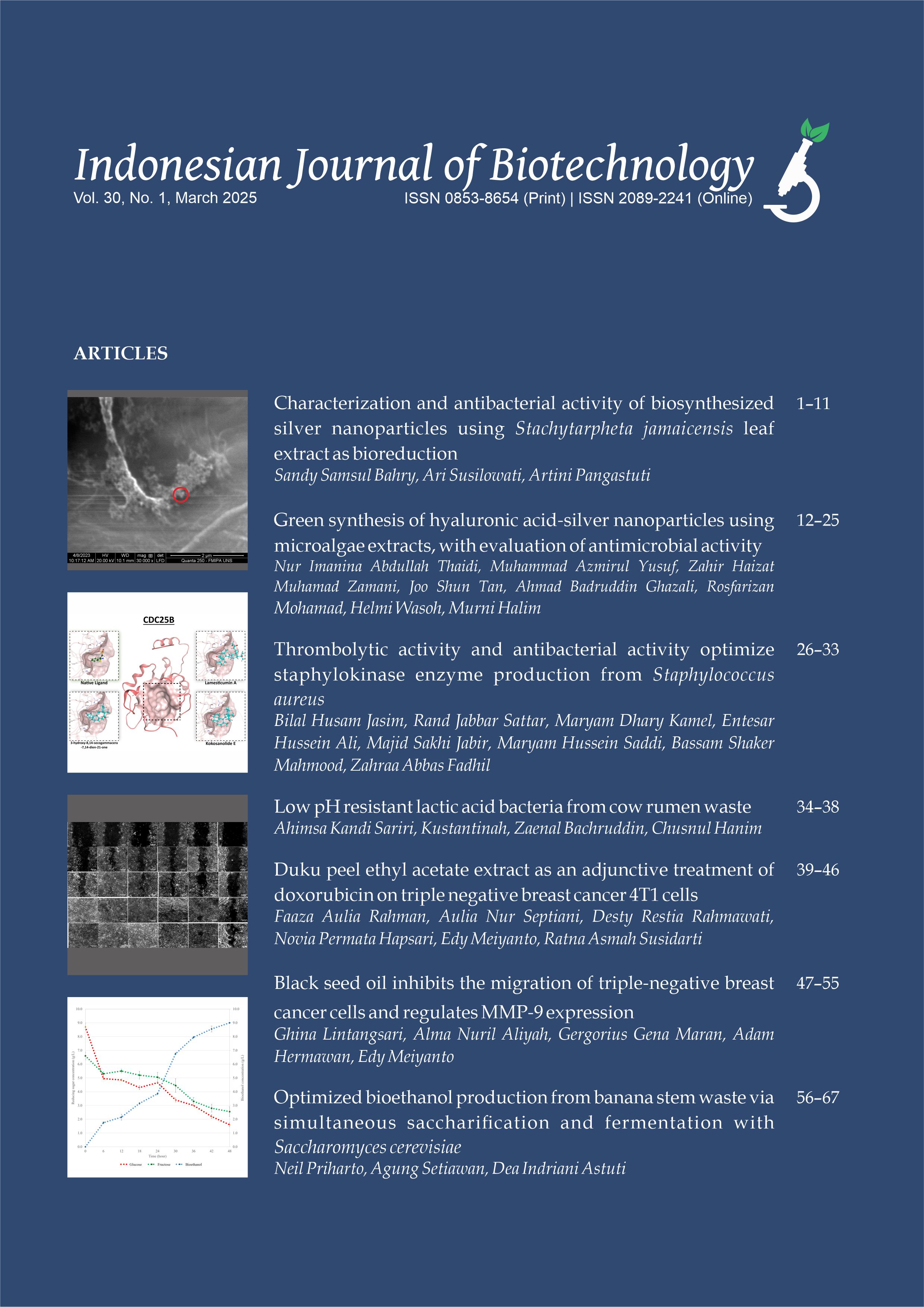In vitro evaluation, molecular docking, and molecular dynamics studies of resorcinol derivatives against yeast α‐glucosidase
Ade Danova(1*), Elvira Hermawati(2), Warinthorn Chavasiri(3), Didin Mujahidin(4), Iqbal Musthapa(5), Fera Kurniadewi(6)
(1) Organic Chemistry Division, Department of Chemistry, Faculty of Mathematics and Natural Sciences, Institut Teknologi Bandung, Jl. Ganesha 10, Bandung, West Java, 40132, Indonesia
(2) Organic Chemistry Division, Department of Chemistry, Faculty of Mathematics and Natural Sciences, Institut Teknologi Bandung, Jl. Ganesha 10, Bandung, West Java, 40132, Indonesia
(3) Center of Excellence in Natural Products Chemistry, Department of Chemistry, Faculty of Science, Chulalongkorn University, Bangkok, 10330, Thailand
(4) Organic Chemistry Division, Department of Chemistry, Faculty of Mathematics and Natural Sciences, Institut Teknologi Bandung, Jl. Ganesha 10, Bandung, West Java, 40132, Indonesia
(5) Chemistry Study Program, Faculty of Mathematics and Natural Science Education, Universitas Pendidikan Indonesia, Jl. Dr. Setiabudi No 229, Bandung 40154, Indonesia
(6) Chemistry Study Program, Universitas Negeri Jakarta, Jalan Rawamangun Muka, Jakarta 13220, Indonesia
(*) Corresponding Author
Abstract
Nine resorcinol derivatives were evaluated for their ability to inhibit yeast α‐glucosidase using the in vitro method. Three molecular docking programs (Autodock Vina, Autodock4 and DockThor) were employed to determine the binding energies. The results showed that two resorcinol derivatives possessing butanoyl (1) and butyl (9) groups demonstrated good inhibitory activity against α‐glucosidase, with IC50 values of 75.9 and 33.3 µM respectively, compared with other derivatives (2–8) and acarbose (IC50 = 832.8 µM). Furthermore, molecular docking indicated that compounds 1 and 9 had better binding affinities than acarbose and the native ligand. Both compounds showed similar interactions with Asp349 and Glu408, which were associated with acarbose and the native ligand. Moreover, molecular dynamics analysis indicated that compound 9 exhibited greater stability than compound 1 when complexed with α‐glucosidase. Therefore, compound 9 has the potential for further studies, both in vitro and in vivo, to evaluate its toxicity, side effects and efficacy.
Keywords
Full Text:
PDFReferences
Ardiansah B, Rohman N, Nasution MAF, Tanimoto H, Cahyana AH, Fadlan A, Ariyani T. 2023. Synthesis, αglucosidase inhibitory activity and molecular docking study of chalcone derivatives bearing a 1H 1,2,3triazole unit. Chem. Pharm. Bull. 71(5):342– 348. doi:10.1248/cpb.c2200844.
Chen YF, Lawal B, Huang LJ, Kuo SC, Sumitra MR, Mokgautsi N, Lin HY, Huang HS. 2023. In vitro and in silico biological studies of 4phenyl2quinolone (4PQ) derivatives as anticancer agents. Molecules 28(2):555. doi:10.3390/molecules28020555.
Dallakyan S, Olson AJ. 2014. Smallmolecule library screening by docking with PyRx. Chemical Biology: Methods and Protocols. Springer. p. 243–250. doi:10.1007/9781493922697_19.
Danova A, Hermawati E, Chavasiri W. 2023a. Synthesis and biological evaluation of N’ arylidene4hydroxybenzohydrazides against α glucosidase enzyme. J. Kartika Kim. 6(2):96–101. doi:10.26874/jkk.v6i2.210.
Danova A, Hermawati E, Chavasiri W, Mujahidin D, Alni A, Roswanda R. 2024a. Discovery of thymolfused chalcones as new competitive αglucosidase inhibitors: Design, synthesis, biological evaluation, and molecular modeling studies. Commun. Sci. Technol. 9(2):322–330. doi:10.21924/cst.9.2.2024.1497.
Danova A, Maulana YE, Hermawati E, Chavasiri W. 2023b. Synthesis, evaluation, and molecular docking study of 4monoacyl resorcinol against tyrosinase enzyme. Indones. J. Chem. Res. 11(2):135–141. doi:10.30598//ijcr.2023.11nov.
Danova A, Pattanapanyasat K, Hengphasatporn K, Shigeta Y, Rungrotmongkol T, Hermawati E, Chavasiri W. 2024b. Unlocking Earylidene steroid derivatives as promising αglucosidase inhibitors. ChemistrySelect 9(9):e202303887. doi:10.1002/slct.202303887.
Dasgupta M, Budday D, De Oliveira SH, Madzelan P, MarchanyRivera D, Seravalli J, Hayes B, Sierra RG, Boutet S, Hunter MS. 2019. Mixandinject XFEL crystallography reveals gated conformational dynamics during enzyme catalysis. Proc. Natl. Acad. Sci. U.S.A. 116(51):25634–25640. doi:10.1073/pnas.1901864116.
Dhameja M, Gupta P. 2019. Synthetic heterocyclic candidates as promising αglucosidase inhibitors: An overview. Eur. J. Med. Chem. 176:343–377. doi:10.1016/j.ejmech.2019.04.025.
Dowarah J, Singh VP. 2020. Antidiabetic drugs: Recent approaches and advancements. Bioorg. Med. Chem. 28(5):115263. doi:10.1016/j.bmc.2019.115263.
Ghani U. 2015. Reexploring promising αglucosidase inhibitors for potential development into oral antidiabetic drugs: Finding needle in the haystack. Eur. J. Med. Chem. 103:133–162. doi:10.1016/j.ejmech.2015.08.043.
Guedes IA, da Silva MMP, Galheigo M, Krempser E, de Magalhães CS, Barbosa HJC, Dardenne LE. 2024. DockThorVS: A free platform for receptorligand virtual screening. J. Mol. Biol. 436(17):168548. doi:10.1016/j.jmb.2024.168548.
Hairani R, Chavasiri W. 2022. A new series of chrysin derivatives as potent nonsaccharide α glucosidase inhibitors. Fitoterapia 163:105301. doi:10.1016/j.fitote.2022.105301.
Hairani R, Chavasiri W. 2025. Synthesis of promising brominated flavonoids as antidiabetic and antiglycation agents. Sci. Rep. 15(1):25517. doi:10.1038/s41598025090409.
Han L, Wang H, Cao J, Li Y, Jin X, He C, Wang M. 2023. Inhibition mechanism of αglucosidase inhibitors screened from Tartary buckwheat and synergistic effect with acarbose. Food Chem. 420:136102. doi:10.1016/j.foodchem.2023.136102.
Hu YK, Wang L, Wang JH, Li MJ, Li F, Yang J, Zhao Y. 2021. Resorcinol derivatives with α glucosidase inhibitory activities from Syzygium samarangense. Nat. Prod. Res. 35(24):5948–5953. doi:10.1080/14786419.2020.1805606.
Ishioka W, Nihei Ki. 2022. Chemical synthesis and tyrosinase inhibitory activity of resorcinol alkyl glucosides, hydroxyalkyl resorcinols, and alkyl resorcinols. J. Mol. Struct. 1268:133668. doi:10.1016/j.molstruc.2022.133668.
Khan H, Jan F, Shakoor A, Khan A, AlAsmari AF, Alasmari F, Ullah S, AlHarrasi A, Khan M, Ali S. 2024. Design, synthesis, molecular docking study, and α glucosidase inhibitory evaluation of novel hydrazide– hydrazone derivatives of 3,4dihydroxyphenylacetic acid. Sci. Rep. 14(1):11410. doi:10.1038/s41598 02462034x.
Kılınç N. 2022. Resorcinol derivatives as novel aldose reductase inhibitors: In silico and in vitro evaluation. Lett. Drug Des. Discov. 19(9):837–846. doi:10.2174/1570180819666220414103203.
Kim TH. 2016. A novel αglucosidase inhibitory constituent from Uncaria gambir. J. Nat. Med. 70:811– 815. doi:10.1007/s1141801610140.
Kongphet M, Hang HTX, Ngo TT, Le TKD, Chavasiri W. 2024. Structural modification of tanshinone IIA and their αglucosidase inhibitory activity. Bioorg. Med. Chem. Lett. 105:129736. doi:10.1016/j.bmcl.2024.129736.
Kshirsagar RP, Kulkarni AA, Chouthe RS, Pathan SK, Une HD, Reddy GB, Diwan PV, Ansari SA, Sangshetti JN. 2020. SGLT inhibitors as antidiabetic agents: A comprehensive review. RSC Adv. 10(3):1733–1756. doi:10.1039/c9ra08706k.
Le TKD, Danova A, Aree T, Duong TH, Koketsu M, Ninomiya M, Sawada Y, Kamsri P, Pungpo P, Chavasiri W. 2022. αglucosidase inhibitors from the stems of Knema globularia. J. Nat. Prod. 85(4):776–786. doi:10.1021/acs.jnatprod.1c00765.
Lee H, Youn I, Noh SG, Kim HW, Song E, Nam SJ, Chung HY, Seo EK. 2024. Identification of bioactive compounds from the roots of Rehmannia glutinosa and their in silico and in vitro AMPK activation potential. Molecules 29(24):6009. doi:10.3390/molecules29246009.
Lee S, Choi H, Park Y, Jung HJ, Ullah S, Choi I, Kang D, Park C, Ryu IY, Jeong Y. 2021. Urolithin and reduced urolithin derivatives as potent inhibitors of tyrosinase and melanogenesis: Importance of the 4substituted resorcinol moiety. Int. J. Mol. Sci. 22(11):5616. doi:10.3390/ijms22115616.
Liu H, Huang P, Wang X, Ma Y, Tong J, Li J, Ding H. 2024a. Apigenin analogs as αglucosidase inhibitors with antidiabetic activity. Bioorg. Chem. 143:107059. doi:10.1016/j.bioorg.2023.107059.
Liu H, Wang Y, Tong J, Li J, Ding H. 2024b. Quercetin analogs as αglucosidase inhibitors with antidiabetic activity. Food Biosci. 58:103713. doi:10.1016/j.fbio.2024.103713.
Nathan DM, Buse JB, Davidson MB, Heine RJ, Holman RR, Sherwin R, Zinman B, American Diabetes Association, European Association for Study of Diabetes. 2006. Medical management of hyperglycemia in type 2 diabetes: a consensus algorithm for the initiation and adjustment of therapy: a consensus statement of the American Diabetes Association and the European Association for the Study of Diabetes. Diabetes Care 29(8):1963–1972. doi:10.2337/dc089025.
Nguyen NT, Nguyen TH, Pham TNH, Huy NT, Bay MV, Pham MQ, Nam PC, Vu VV, Ngo ST. 2019. Autodock vina adopts more accurate binding poses but autodock4 forms better binding affinity. J. Chem. Inf. Model. 60(1):204–211. doi:10.1021/acs.jcim.9b00778.
Shimizu K, Kondo R, Sakai K. 2000. Inhibition of tyrosinase by flavonoids, stilbenes and related 4substituted resorcinols: structureactivity investigations. Planta Med. 66(01):11–15. doi:10.1055/s200011113.
Sun H, Saeedi P, Karuranga S, Pinkepank M, Ogurtsova K, Duncan BB, Stein C, Basit A, Chan JC, Mbanya JC. 2022. IDF Diabetes Atlas: Global, regional and countrylevel diabetes prevalence estimates for 2021 and projections for 2045. Diabetes Res. Clin. Pract. 183:109119. doi:10.1016/j.diabres.2021.109119.
Trott O, Olson AJ. 2010. AutoDock Vina: Improving the speed and accuracy of docking with a new scoring function, efficient optimization, and multithreading. J. Comput. Chem. 31(2):455–461. doi:10.1002/jcc.21334.
Yuca H. 2024. An approach throughout in vitro studies on natural compounds as αglucosidase inhibitors: A review. Stud. Nat. Prod. Chem. 83:249–292. doi:10.1016/B9780443222146.000168.
Zainab, Khan F, Alam A, Rehman NU, Ullah S, Elhenawy AA, Ali M, Islam WU, Khan A, AlHarrasi A, et al. 2025. Synthesis, anticancer, α glucosidase inhibition, molecular docking and dynamics studies of hydrazoneSchiff bases bearing polyhydroquinoline scaffold: In vitro and in silico approaches. J. Mol. Struct. 1321:139699. doi:10.1016/j.molstruc.2024.139699.
Article Metrics
Refbacks
- There are currently no refbacks.
Copyright (c) 2025 The Author(s)

This work is licensed under a Creative Commons Attribution-ShareAlike 4.0 International License.









